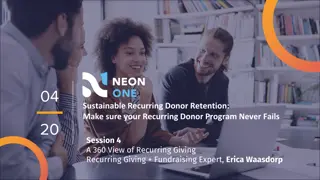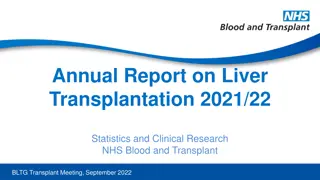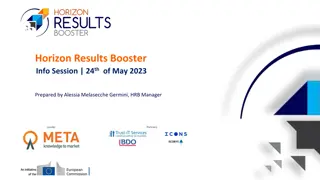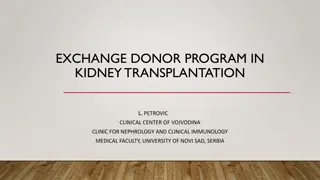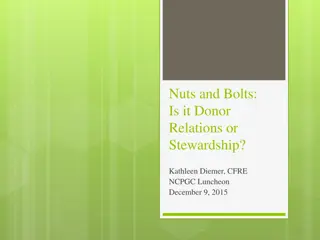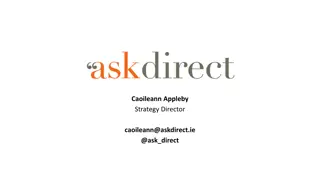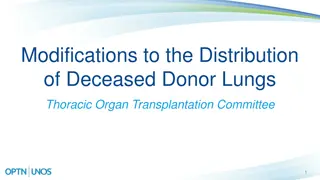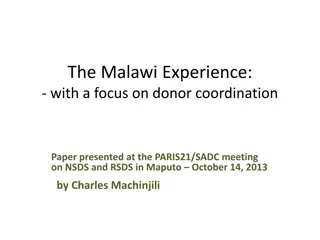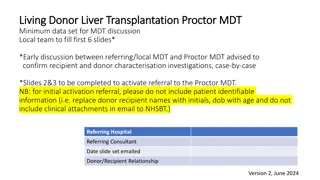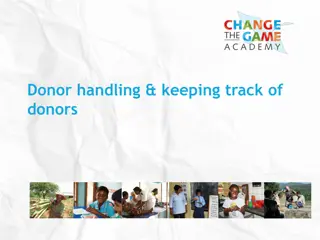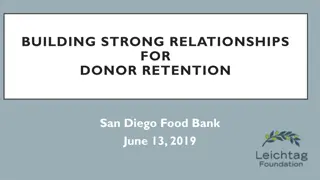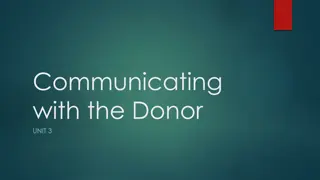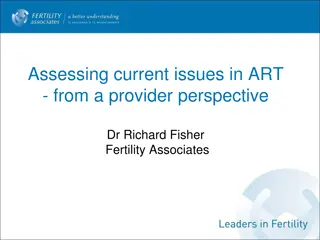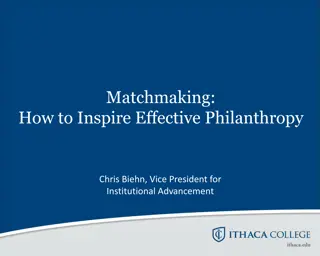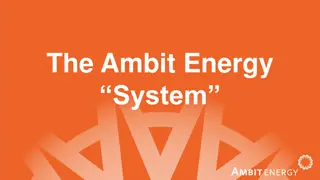Maximizing Donor Prospects Through Technology & Strategic Planning
Discover the latest strategies in identifying major gift donors through technology and data-driven insights presented at the ADVIS Annual Development Retreat. Experts from Schultz & Williams shared valuable insights on assessing fundraising performance, donor engagement, and growth opportunities in the nonprofit sector. Learn about innovative solutions and best practices to enhance development programs and drive impactful fundraising campaigns.
Download Presentation

Please find below an Image/Link to download the presentation.
The content on the website is provided AS IS for your information and personal use only. It may not be sold, licensed, or shared on other websites without obtaining consent from the author. Download presentation by click this link. If you encounter any issues during the download, it is possible that the publisher has removed the file from their server.
E N D
Presentation Transcript
ADVIS Annual Development Retreat February 13, 2018
Finding Your Best Donor Prospects Through the Magic of Today s Technology
Presenters Pat Voigt Senior Consultant Kelly Grattan Senior Consultant
Introductions Name, Position, School
About Schultz & Williams National planning and consulting firm providing strategic and innovative solutions to the nonprofit sector. Established in 1987 Offices in: Philadelphia Washington DC San Francisco Los Angeles Nonprofit clients of all types and sizes Creative solutions, multiple strategies one size does not fit all
Development Consulting S&W StaffSolutions Marketing Business & Strategic Financial Planning S&W Direct
Objectives 1. Inventory ways in which you currently identify mid- level and major gift donors 2. Identify methods for: 1. Fully understanding current fundraising performance, including strengths, weaknesses, and opportunities 2. Qualifying individuals to determine if they are prospects and at what level 3. Explore ways in which schools are currently utilizing these methods and best practices
First things first How do we assess the performance of our operation to fully understand our strengths and weaknesses and our opportunities for growth?
S&W ProFile 360 view of how donors are engaging with the school, identifies recent and historic trends, and uncovers gaps in giving that may be relevant to potential major gifts and strategy. Fosters a better understanding of the current state of the school s prospect pool and the major donor pipeline, with a sharper eye towards metrics that relate to the potential for significant growth of the development program. Returns a full set of data points relevant to growth opportunities and critical insights into fundraising trends. Provides a foundation for data driven decision
Independent school, grades 7-12 Ran the ProFile as part of the internal assessment in a campaign planning study DoD wanted confirmation of overall performance improvement DoD also wanted to know any weaknesses in the development program Case Study #1
Case Study #1 Approach & Findings Analyzed 8 years of giving (cash only) Only 32% of revenue comes from the top 10 donors sign of donor pool health Insignificant revenue is lost from donors who decreased giving under $500k vs. nearly $1.5m in increased giving Overall retention was only 57% better than the national average of 41-43% across all non- profits, but not as high as the 60% rate for independent schools
Development Program Overview
Distribution by Gift Level
Philanthropic Revenue from Individuals
FY17 Donor Distribution by State
How do you currently add individuals to the prospect pool? In small groups How do you qualify these individuals, if at all?
Annual reports from similar schools or related organizations (e.g., Jesuit organizations) Introductions to family/friends of board members, volunteers and donors Finding Prospects New parents New alums
But how do we know if these individuals are good prospects and at what level we should target them?
Philanthropic Capacity Screening Also known as wealth screening, which focuses on capacity but not philanthropic inclination Critical 1st step in understanding who is in your universe Worth the investment! Many options on the market today How do you choose? Run it every 2-3 years, or at least consider running new parents (if considered potential prospects) through each summer/fall.
Who is currently using these tools? Which one(s)?
Disclaimer S&W receives no discount or benefits from any vendor Nor do we receive any sort of credit/compensation from any vendor to refer clients. Our preferences stem from personal experience with and knowledge of the tools. Please choose the tool(s) that work best for your organization.
S&Ws Qualification Philosophy
Screening Tools (S&W ranked) 1. DonorSearch Strong match logic: confidence that the person screened is the person in our database Constant review of the subscription databases the information is pulled from Strong capacity and very robust philanthropy WealthEngine & iWave Strong capacity Weak philanthropy Iffy match logic ResearchPoint (Blackbaud Target Analytics) Strong match logic (though not as robust as DonorSearch) Decent capacity Weak philanthropy Beware: will heavily weigh affinity as expressed through giving history in determining giving ranges (refer to Case Study #1) 2. We know these tools LOOK better, but don t let that guide your decision. 3.
Independent school, grades 9-12 About to conduct a campaign planning study to test a goal of $40 million for capital/endowment First ran ResearchPoint screening during their transition to NXT Unique scenario: The school knows its alums are extremely loyal and connected BUT up until last year, no one was asking them for anything more than a token annual gift. Case Study #2
Case Study #2 Approach & Findings S&W reviewed the ResearchPoint ratings (!!) ResearchPoint factored in affinity which it measured by giving history. The results indicated most alums were not in a position to make a major gift because affinity trumped capacity and philanthropic inclination. Word of caution: When using ResearchPoint, do not provide giving history if you believe it is not an indicator of affinity, like in this scenario. S&W then ran the full database through DonorSearch extraordinary findings! 250+ can give $500,000 or more! 500+ can $250,000 or more!
Independent school, grades pre-K through 8 Conducted a mid-campaign assessment ($1.5 million capital campaign) to help raise the remaining 2/3 of the goal Never screened their records Case Study #3
Case Study #3 Approach & Findings S&W ran the full database through DonorSearch. Results indicated the School s database is not saturated with prospects at the very top levels of capacity. Confirmed target ask amounts in line or higher than those the development team had in mind gave the team confidence to proceed. Results highlighted things like where parents are at in terms of their philanthropic lifecycle.
Sample Finding Note: DoD overheard a parent tell his spouse that he never really thought about giving to the school and wasn t sure why; he seemed surprised that he didn t realize the school needed charitable gifts each year. He indicated that he was giving to another school without much thought but should probably redirect the gift to their children s school. DS results showed this family has moderate capacity and could make a small campaign gift of approximately $25,000 over 3 years. Current philanthropic activity in the results showed the couple s only giving was to the father s alma mater, which confirms the overheard conversation. Based on the DS findings and what the DoD knows about this young couple, it s clear they haven t yet found their cause and are in the perfect position to be cultivated.
Prospect Identification Modeling Finding the next generation of major gift donors (as defined by you) Produces a list of very warm prospects who haven t yet made a major gift or are underperforming at the major gift level Includes only those poised to springboard to the major gift level Only works if you have a history of giving
Custom Algorithm (based on affinity: giving history & engagement) 1. Mapping out behavioral indicators of the school s current major donors: 3. Modeling begins, focused on: Those who are on a similar path of the current major donors Current retention vs. maximum years of retention Largest gift in relation to first gift amount Increased giving (number of gifts and/or amount of gifts) Attending events, advocacy efforts, membership (if applicable and recorded) First gift amount & channel How long it took to get to the major gift threshold Any giving changes that set them on a trajectory toward a major gift Etc. 2. Algorithm is then weighted
Small university Frustrated with plateaued giving Haven t screened records in many years Case Study #4
Case Study #4 Approach & Findings S&W ran the full database through DonorSearch, and then conducted Prospect Identification Modeling. The DS results were used to qualify the capacity of the modeled donors. A typical modeling effort yields 100-300 highly-qualified major gift prospects. We found over 500 hot major gift prospects! This confirmed what we already suspected from our work with the school: they haven t been actively cultivating, soliciting and upgrading most of their constituents.
Questions? Contact us anytime! pvoigt@schultzwilliams.com kgrattan@schultzwilliams.com









